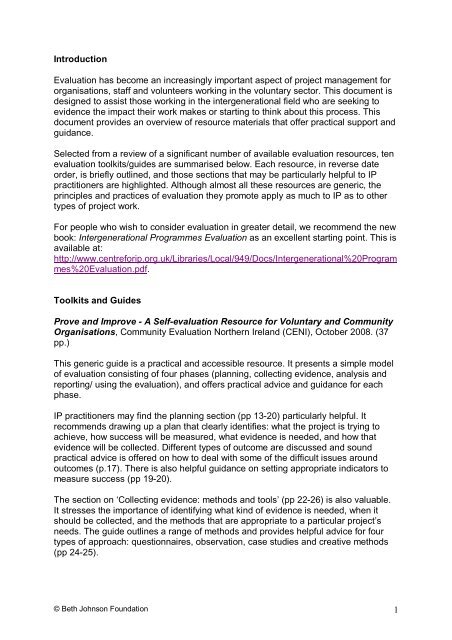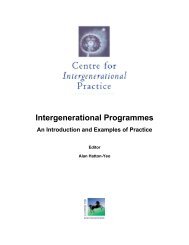Evaluating Intergenerational Projects: A Practical Guide to Useful ...
Evaluating Intergenerational Projects: A Practical Guide to Useful ...
Evaluating Intergenerational Projects: A Practical Guide to Useful ...
You also want an ePaper? Increase the reach of your titles
YUMPU automatically turns print PDFs into web optimized ePapers that Google loves.
IntroductionEvaluation has become an increasingly important aspect of project management fororganisations, staff and volunteers working in the voluntary sec<strong>to</strong>r. This document isdesigned <strong>to</strong> assist those working in the intergenerational field who are seeking <strong>to</strong>evidence the impact their work makes or starting <strong>to</strong> think about this process. Thisdocument provides an overview of resource materials that offer practical support andguidance.Selected from a review of a significant number of available evaluation resources, tenevaluation <strong>to</strong>olkits/guides are summarised below. Each resource, in reverse dateorder, is briefly outlined, and those sections that may be particularly helpful <strong>to</strong> IPpractitioners are highlighted. Although almost all these resources are generic, theprinciples and practices of evaluation they promote apply as much <strong>to</strong> IP as <strong>to</strong> othertypes of project work.For people who wish <strong>to</strong> consider evaluation in greater detail, we recommend the newbook: <strong>Intergenerational</strong> Programmes Evaluation as an excellent starting point. This isavailable at:http://www.centreforip.org.uk/Libraries/Local/949/Docs/<strong>Intergenerational</strong>%20Programmes%20Evaluation.pdf.Toolkits and <strong>Guide</strong>sProve and Improve - A Self-evaluation Resource for Voluntary and CommunityOrganisations, Community Evaluation Northern Ireland (CENI), Oc<strong>to</strong>ber 2008. (37pp.)This generic guide is a practical and accessible resource. It presents a simple modelof evaluation consisting of four phases (planning, collecting evidence, analysis andreporting/ using the evaluation), and offers practical advice and guidance for eachphase.IP practitioners may find the planning section (pp 13-20) particularly helpful. Itrecommends drawing up a plan that clearly identifies: what the project is trying <strong>to</strong>achieve, how success will be measured, what evidence is needed, and how thatevidence will be collected. Different types of outcome are discussed and soundpractical advice is offered on how <strong>to</strong> deal with some of the difficult issues aroundoutcomes (p.17). There is also helpful guidance on setting appropriate indica<strong>to</strong>rs <strong>to</strong>measure success (pp 19-20).The section on ‘Collecting evidence: methods and <strong>to</strong>ols’ (pp 22-26) is also valuable.It stresses the importance of identifying what kind of evidence is needed, when itshould be collected, and the methods that are appropriate <strong>to</strong> a particular project’sneeds. The guide outlines a range of methods and provides helpful advice for fourtypes of approach: questionnaires, observation, case studies and creative methods(pp 24-25).© Beth Johnson Foundation 1






